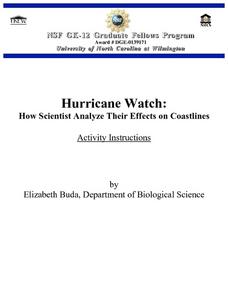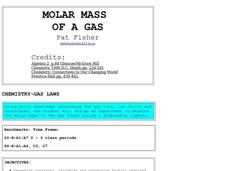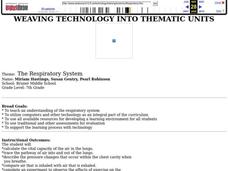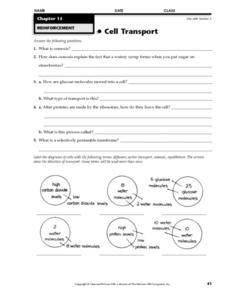Curated OER
Hurricane Watch: How Scientist Analyze Their Effects on Coastlines
Eighth graders are able to evaluate the forces that shape the lithosphere. They explore background information on hurricanes by completing a webquest and answering questions. Students present their reports to the class. The class...
Curated OER
Molar Mass
Students apply the ideal gas law and Dalton's Law of Partial Pressure to develop an experiment which determine the molar mass of butane from disposable lighters. In small groups, they develop a procedure and have it approved before...
Curated OER
What Is an Egg Without its Shell?
Pupils observe osmosis, a cellular process that normally can't be observed without a microscope, and use scientific method to observe osmosis in a chicken egg.
Curated OER
A Multimedia Presentation to Describe Newton's Laws of Motion
Eighth graders use various sources to find pictorial evidence of Newton's laws of motion in everyday life. They use various sources of technology to import those pictures into a multimedia presentations.
Curated OER
Looking Inside Cells
Seventh graders analyze and identify the role of the cell membrane and nucleus. They create flash cards to help them review cell structures. They also compare plant and animal cells.
Curated OER
Classification of Pasta, Rice and the Nine Planets
Eighth graders create a classification system of the planets and give a written rational for their choice of categories. In this investigative lesson students participate in an activity that helps them to explore classification.
Curated OER
The Moving Continents from Pangaea to the Future
Eighth graders examine how the movements of the Earth contribute to fossil distribution. In this fossils lesson students make maps of the placement of the continents.
Curated OER
Space Exploration Missions
Eighth graders explore and discuss the various space exploration missions. In this space mission lesson students work in pairs and create a PowerPoint presentation on the contributions of space exploration missions.
Curated OER
The Respiratory System
The student will calculate the vital capacity of the air in the lungs and trace the pathway of air into and out of the lungs. They describe the pressure changes that occur within the chest cavity when you breathe. They compare air that...
Curated OER
Wildlife Sampling-Capture-Recapture
Seventh graders simulate the capture-recapture method of population sampling using beans. In this biology lesson, 7th graders calculate the total population of beans in the bowl. They assess whether this method is reliable or not.
Curated OER
Electricity Layered Curriculum
Students describe how electric charges exert forces on each other as well as compare the strengths of electric and gravitational forces. They distinguish between conductors and insulators. In addition, students examine voltage and...
Curated OER
Cell Transport
In this biology worksheet, 9th graders describe what osmosis is and how it explains the fact tat a watery syrup forms when you put sugar on strawberries. Then they describe how proteins made by ribosomes leave the cell. Students also...
Curated OER
Cell Growth and Division
In this biology worksheet, 9th graders identify and explain what cell stay in inter-phase. Then they describe which stage of cell is the shortest and determine why that is true. Students also explain the process of mitosis.
Curated OER
Sexual Reproduction and Meiosis
In this biology worksheet, 9th graders create one chromosome using a red plasticine and another using blue plasticine. Then they illustrate different ways of crossing over, including double crossovers. Students also explain genetic...
Curated OER
DNA
In this DNA worksheet, 9th graders read a brief excerpt pertaining to the genetic code and identify how proteins know which cell to create. Then they use the genetic code dictionary to draw a diagram showing the codons for an imaginary...
Curated OER
Fossils
In this fossil instructional activity, students match six terms with their definitions about types of fossils and they circle the proper term to make nine statements true about preservation of fossils.
Curated OER
Mathematical Techniques - Basic Graphing
Students are introduced to significant figures and how to add, subtract, multiply and divide them. In a group, they practice plotting data points from a table to a graph and labeling all axes. They calculate the slope and y-intercept and...
Curated OER
Earth's Crust in Motion
In this Earth's crust instructional activity, students will review the different ways the crust is moving including soil erosion and earthquakes. Students will complete 6 word scramble/fill in the blank, 3 multiple choice, and 11 short...
Curated OER
Impulse and Momentum
Students are introduced to the concepts of impulse and momentum and problem solving strategies for these types of problems. In groups, they discover the law of conservation of momentum and share their answers with the class.
Curated OER
Air Bag Safety
In this air bag safety worksheet, students will read a newspaper article about how air bags might be dangerous to small children. Students will write an essay discussing their ideas about air bag safety.
Curated OER
Weather
In this weather worksheet, students will match 4 weather terms to their correct definition. Vocabulary words include wind, weather, air mass, and front. Then students will complete 3 short answer questions based on high and low air...
Curated OER
Forecasting the Weather
In this weather worksheet, learners will determine what a meteorologist is and the ways scientists are currently experimenting with to control the weather. This worksheet has 4 short answer questions.
Curated OER
Space Exploration - Boom or Bust?
In this space exploration learning exercise, learners will label if 5 statements support space exploration or not. Then students will complete 2 short answer questions giving their opinion about three things that are good and three...
Curated OER
The Actinide Group
For this elements worksheet, students learn about the elements found in the actinide group including those that occur naturally and those that have been artificially produced. This worksheet has 5 short answer questions.























